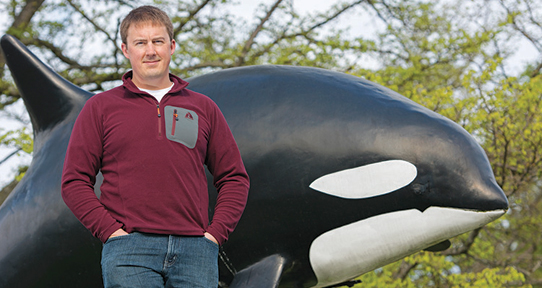The orca revolution

A UVic historian tracks the impact of this iconic species on our regional identity
by Valerie Shore
We see them everywhere in Victoria. On postcards, t-shirts, tourist brochures, billboards, hockey jerseys, you name it. There’s even a topiary downtown that is shaped in their unmistakable form.
Killer whales, or orcas, are a fundamental part of our West Coast culture and are probably the most beloved wild animal in this region. But it wasn’t always this way. Fifty years ago, killer whales were generally seen as ferocious beasts that were greedily taking salmon away from our dinner plates.
So what changed? How did this transformation from reviled pest to sacred icon take place? That’s the overarching question on the mind of University of Victoria historian Jason Colby as he delves into the complex and emotionally charged history of killer whales and humans over the last half-century in the Pacific Northwest.
“In the process of people capturing these whales, displaying them, learning about them and arguing over them, there are fundamental questions of who we are and what’s important to us in this region,” says Colby, who studies international and environmental history and how they intersect with culture.
The waters off southern British Columbia and northern Washington State were ground zero for what the world now knows about killer whales. The first pivotal moment came in July 1964, when a young male killer whale was harpooned off BC’s Saturna Island to use as a model for a sculpture. But he didn’t die as planned.
The whale, mistaken for a female and dubbed Moby Doll, was towed alive to Vancouver where he enchanted scientists and the public with his intelligence and docility. He died less than three months later, but his short tenure in captivity—the world’s first—triggered an orca gold rush.
Between 1965 and 1976 almost 50 killer whales were captured in BC and Washington State waters and hauled off to marine parks. Another 13 or more died during capture.
It is these tumultuous years—and their impact on the culture and environmental history of this region—that intrigue Colby, who is scouring public archives, digging into the history of marine parks, and interviewing many of the key players for a book on the topic.
Colby can trace how the capture controversy started off with local people, especially those involved in fisheries, making decisions unfettered. But as the captures continued, public opposition built, court battles ensued, and the Canadian and US governments stepped in to regulate.
“Officials in both countries go from seeing the whales as pests and threats, to commodities to be extracted, to special creatures that we can’t let anyone take out of our waters. It’s quite remarkable.”
At the time, there were long-standing tensions across the border, which the emerging environmental movement helped bridge. The evolving relationship with orcas contributed to that change, says Colby.
“When businessmen, scientists and activists are arguing or cooperating across a border over something, it forces all of us to see it as a transnational issue. Killer whales spurred people to think about the marine ecosystem as a whole.”
That legacy continues today as the whales’ long-term survival is uncertain. Colby hopes his book will add fresh perspective. “Ultimately, I’m a historian telling a human story. I want to tell it in a way that makes people on both sides of the border think about this is as a shared history, and something that needs a shared solution.”
View as PDF (316K).
For millennia, Indigenous peoples along the northwest coast of North America have regarded the killer whale with awe and respect, and it is featured prominently in their art and culture.
Of the whales captured in the 1960s and ‘70s, the southern resident killer whales routinely seen off Victoria were the most heavily impacted, with 40 whales collected and at least 11 killed. The population has never recovered—there are only 81 of them—and is listed as endangered in both Canada and the US.
The captures not only transformed our view of killer whales, but led governments to turn to scientists to learn more about them. Those benchmark studies, which continue to this day on both sides of the border, led to the permanent protection of killer whales on this coast.
The main threats facing the southern resident killer whales are: the sharp decline of their main prey, chinook salmon; pollution; and environmental stressors such as ocean noise from shipping, resource exploration and sonar. Funded by a grant from the Social Sciences and Humanities Research Council, Colby involves graduate and undergraduate students in his research on environmental and animal history. In coming years, he’ll offer an undergraduate seminar entitled “Beastly Nation: Animals and People in US History.”
View all Faces of UVic Research videos.
